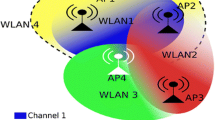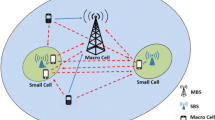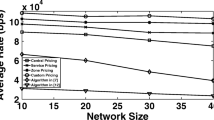Abstract
We consider the problem of decentralized rate selection in IEEE 802.11 wireless local area networks (WLANs). Owing to the decentralized nature of WLANs, we formulate the current problem of rate selection as a non-cooperative game where individual users (players) of a WLAN can pick their actions from a finite set of physical layer modulation rates. The utility of each user is the difference of throughput and a cost incurred due to the price imposed by the access point. We prove the resulting non-cooperative game to be supermodular, and hence has at least one pure strategy Nash equilibrium, that is contained in a set bounded by the smallest and largest Nash equilibria. We also prove the smallest and largest Nash equilibria to be non-decreasing functions of the price and the smallest Nash equilibrium to be Pareto-dominant. We present an algorithm to compute the best response of each user asynchronously, that converges almost surely to the smallest Nash equilibrium of the game. Next we extend our price based approach to the multi-channel case and prove the resulting game to be supermodular in the special case of two channels. Our simulation results demonstrate the improvement in overall network throughput with appropriate tuning of the price.
Similar content being viewed by others
References
Andradottir S. (1996) A global search method for discrete stochastic optimization. SIAM Journal on Optimization 6(2): 513–530
Bianchi G. (2000) Performance analysis of the IEEE 802.11 distributed Coordination Function. IEEE Journal on Selected Areas in Communications 18(3): 535–547
Cullen H. F. (1961) Complete continuity for functions. The American Mathematical Monthly 68(2): 165–168
Currarini S., Marini M.A. (2004) A conjectural cooperative equilibrium for strategic form games. In: Carraro C., Fragnelli V. (eds) Book Chapter in game practise and the environment. Cheltenham, Edward Elgar Publishers
de Mello T.H. (2003) Variable-sample methods for stochastic optimization. ACM Transactions on Modeling and Computer Simulation 13(2): 108–133
Fudenberg D., Tirole J. (1996) Game theory. MIT Press, Cambridge, MA
Heusse, M., Rousseau, F., Berger-Sabbatel, & G., Duda, A. (2003). Performance Anomaly of 802.11b. In Proceedings of IEEE INFOCOM 2003 (pp. 836–843).
Heusse, M., Rousseau, F., Guillier, R., & Duda, A. (2005) Idle sense: An optimal access method for high throughput and fairness in rate diverse wireless LANs. In Proceedings of ACM SIGCOMM 2005 (pp. 121–132).
Huang J., Berry R. A., Honig M. L. (2006) Distributed interference compensation in wireless networks. IEEE Journal on Selected Areas in Communications 24(5): 1074–1084
IEEE 802.11 standard for wireless LAN medium access control (MAC) and physical layer (PHY) specifications. Available at http://standards.ieee.org/getieee802/download/802.11b-1999.pdf.
Krishnamuthy V., Wang X., Yin G. (2004) Spreading code optimization and adaptation in CDMA via discrete stochastic approximation. IEEE Transactions on Information Theory 50(9): 1927–1949
Liu P., Tao Z., Narayanan S., Korakis T., Panwar S. S. (2007) CoopMAC: A cooperative MAC for wireless LANs. IEEE Journal on Selected Areas in Communications 25(2): 340–354
Mas-Colell A., Whinston M. D., Green J. R. (1995) Microeconomic theory. Oxford University Press, Oxford, UK
Milgrom P., Roberts J. (1990) Rationalizability, learning, and equilibrium in games with strategic complementarities. Econometrica 58(6): 1255–1277
Osborne M. J., Rubinstein A. (1994) A course in game theory. MIT Press, Cambridge, MA
Proakis J. G. (2000) Digital communications. McGraw Hill, New York
Saraydar C. U., Mandayam N. B., Goodman D. J. (2002) Efficient power control via pricing in wireless data networks. IEEE Transactions on Communications 50(2): 291–303
Tan G., & Guttag, J. (2004). Time-based fairness improves performance in multi-rate WLANs. In Proceedings of USENIX annual technical conference, 2004, p. 23.
Tan, G., & Guttag, J. (2005) The 802.11 MAC leads to Inefficient Equilibria. In Proceedings of IEEE INFOCOM 2005 (pp. 1–11).
Topkis D. M. (1998) Supermodularity and Complementarity. Princeton University Press, New Jersey
Wang F., Krunz M., Cui S. (2008) Price-Based Spectrum Management in Cognitive Radio networks. IEEE Journal on Selected Topics in Signal Processing 2(1): 74–87
Author information
Authors and Affiliations
Corresponding author
Additional information
The authors would like to thank the Natural Sciences and Engineering Research Council (NSERC) of Canada for their research support in the form of a strategic grant.
Rights and permissions
About this article
Cite this article
Pillutla, L.S., Krishnamurthy, V. A Price Based Decentralized Rate Selection in IEEE 802.11 Based WLANS. Wireless Pers Commun 56, 517–534 (2011). https://doi.org/10.1007/s11277-010-9987-6
Published:
Issue Date:
DOI: https://doi.org/10.1007/s11277-010-9987-6




